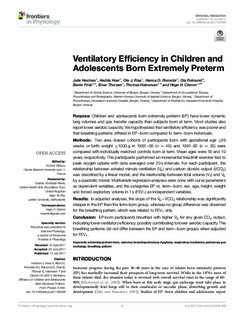| dc.contributor.author | Hestnes, Julie | |
| dc.contributor.author | Hoel, Hedda Benedicte | |
| dc.contributor.author | Risa, Ole J. | |
| dc.contributor.author | Romstøl, Hanna O. | |
| dc.contributor.author | Røksund, Ola Drange | |
| dc.contributor.author | Frisk, Bente | |
| dc.contributor.author | Thorsen, Einar | |
| dc.contributor.author | Halvorsen, Thomas | |
| dc.contributor.author | Clemm, Hege Synnøve Havstad | |
| dc.date.accessioned | 2019-04-03T10:23:02Z | |
| dc.date.available | 2019-04-03T10:23:02Z | |
| dc.date.created | 2017-09-13T12:49:41Z | |
| dc.date.issued | 2017 | |
| dc.identifier.citation | Hestnes, J., Hoel, H., Risa, O. J., Romstøl, H. O., Røksund, O., Frisk, B., . . . Clemm, H. H. (2017). Ventilatory Efficiency in Children and Adolescents Born Extremely Preterm. Frontiers in Physiology, 8. | nb_NO |
| dc.identifier.issn | 1664-042X | |
| dc.identifier.uri | http://hdl.handle.net/11250/2593116 | |
| dc.description.abstract | Purpose: Children and adolescents born extremely preterm (EP) have lower dynamic lung volumes and gas transfer capacity than subjects born at term. Most studies also report lower aerobic capacity. We hypothesized that ventilatory efficiency was poorer and that breathing patterns differed in EP−born compared to term−born individuals.
Methods: Two area−based cohorts of participants born with gestational age ≤28 weeks or birth weight ≤1000 g in 1982−85 (n = 46) and 1991–92 (n = 35) were compared with individually matched controls born at term. Mean ages were 18 and 10 years, respectively. The participants performed an incremental treadmill exercise test to peak oxygen uptake with data averaged over 20 s intervals. For each participant, the relationship between exhaled minute ventilation (V˙E) and carbon dioxide output (V˙CO2) was described by a linear model, and the relationship between tidal volume (VT) and V˙E by a quadratic model. Multivariate regression analyses were done with curve parameters as dependent variables, and the categories EP vs. term−born, sex, age, height, weight and forced expiratory volume in 1 s (FEV1) as independent variables.
Results: In adjusted analyses, the slope of the V˙E−V˙CO2 relationship was significantly steeper in the EP than the term-born group, whereas no group difference was observed for the breathing pattern, which was related to FEV1 only.
Conclusion: EP-born participants breathed with higher V˙E for any given CO2 output, indicating lower ventilatory efficiency, possibly contributing to lower aerobic capacity. The breathing patterns did not differ between the EP and term−born groups when adjusted for FEV1. | nb_NO |
| dc.language.iso | eng | nb_NO |
| dc.publisher | Frontiers Media S.A. | nb_NO |
| dc.rights | Navngivelse 4.0 Internasjonal | * |
| dc.rights.uri | http://creativecommons.org/licenses/by/4.0/deed.no | * |
| dc.subject | extremely preterm born | nb_NO |
| dc.subject | exercise | nb_NO |
| dc.subject | bronchopulmonary dysplasia | nb_NO |
| dc.subject | respiratory mechanics | nb_NO |
| dc.subject | pulmonary gas exchange | nb_NO |
| dc.subject | breathing pattern | nb_NO |
| dc.title | Ventilatory efficiency in children and adolescents born extremely preterm | nb_NO |
| dc.type | Journal article | nb_NO |
| dc.type | Peer reviewed | nb_NO |
| dc.description.version | publishedVersion | nb_NO |
| dc.rights.holder | Copyright © 2017 Hestnes, Hoel, Risa, Romstøl, Røksund, Frisk, Thorsen, Halvorsen and Clemm. | nb_NO |
| dc.subject.nsi | VDP::Medisinske Fag: 700::Helsefag: 800::Fysioterapi: 807 | nb_NO |
| dc.source.pagenumber | 1-8 | nb_NO |
| dc.source.volume | 8 | nb_NO |
| dc.source.journal | Frontiers in Physiology | nb_NO |
| dc.identifier.doi | 10.3389/fphys.2017.00499 | |
| dc.identifier.cristin | 1493318 | |
| cristin.unitcode | 203,3,11,0 | |
| cristin.unitname | Institutt for ergo/fysio/radio - Bergen | |
| cristin.ispublished | true | |
| cristin.fulltext | original | |
| cristin.qualitycode | 1 | |

